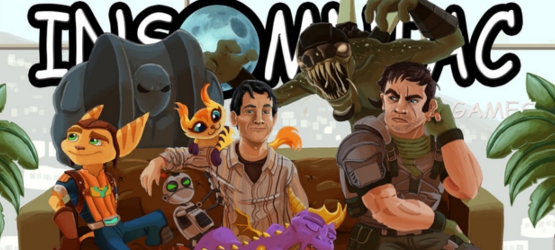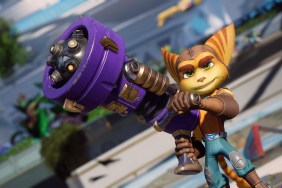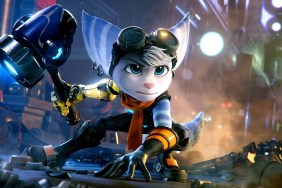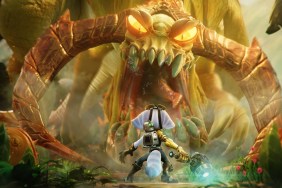During a preview event for Insomniac Games’ upcoming third person shooter, Fuse, CEO and Founder Ted Price took a few moments to sit down with PlayStation LifeStyle to answer a few questions as well as ask a few himself.
Dan Oravasaari: Hi Ted, Could you tell me a little bit about Fuse?
Ted Price: Fuse is a brand new game, and intellectual property from Insomniac Games, which is getting set to launch on May 28th. The game itself features a team of four agents who are traveling across the globe and beyond, chasing a volatile alien substance called Fuse. The game takes place in an imaginary future, it doesn’t have anything to do with real world conflicts that exist today. Our intent with the game was to: A) to tell a story that could only come from Insomniac, and B) to provide co-op features you wouldn’t be able to find in any other game, thus raising the bar for co-op.
Was it difficult to find a new and interesting way to do co-op, given the countless other titles that have done it this generation?
When we thought about what we needed to do with the co-op, the first thing that came to mind was to move away from what we believed was the standard approach, which usually falls down to all four players operating as clones, having the same essential abilities and doing the same things. We wanted to change that by introducing different character arch-types for each of the four cooperative players, something that would be driven by some special weapons in the game. During production, we started adding to that concept by creating combinations between weapons in ways we didn’t expect at first. But, as we built out more functionality for the Magshield, the Shattergun, the Archshot and the Warp Rifle, it became apparent that we could combine them in some unique fashions and add another layer of complexity to the co-op mechanics that we hadn’t originally envisioned.
Does owning your own IP for Fuse change how you approached development compared to previous Insomniac Games’ titles like Resistance? And has it impacted how you planned for the future?
The answer to the first question is no, and the answer to the second question is yes. We’ve had a great relationship with Sony over the years, in that we operated autonomously when it came to creating Resistance and Ratchet. Those had been driven by Insomniac Games and we’ve evolved, we worked hard to evolve them with Sony’s support.
With Fuse, same thing. It was our idea, we have continued to modify the game on what works from a core fun factor and EA has been supportive of that. But, to directly answer your second question, because we own the IP, it absolutely means we have more latitude in terms of where can take it in the future – in terms of platforms and in terms of mechanics, delivery mechanisms, you name it – and that is a wonderful place to be.
Insomniac Games is well known for their implementation of a variety of weapons in their titles, was it an obvious choice to once again go down that road with a new IP? And do you feel that was something that is now expected from Insomniac Games?
Well it’s what we love to do, and it has become expected from us because we love to do it. We’ve put a lot of energy and passion into coming up with unique weapons, and with every new franchise we create, it has been one of the most enjoyable challenges to come up with crazy over-the-top unexpected arsenals.
In the case of Fuse, we had to make a decision about whether to go broad or deep, and we decided to go deep and focus on a smaller number of weapons that could be upgraded/modified throughout the game. We did that because we wanted the weapons and the combat strategy to be deep as well. Sometimes when we throw tons of weapons at players it becomes less apparent what the differences are between them and some just don’t seem to fit in – making it harder to develop a coherent strategy, because all of the weapons start to take the same tone.
But, it was complicated by the fact that we really did want each of those 4 characters to have unique function in the game driven by those weapons, so we knew that we had to come up with an anchor for each of the characters, as well as having the anchor fit with the other three characters – and that equation took a long time to solve.
With the Ratchet & Clank games you have had dozens of weapons available, as well as having fans submit some for contests, what is the process behind internally developing and choosing which kind of weapons to put in a game?
Well that really depends on the game. We took a different approach [with Fuse] than we did with Ratchet, and a different approach than we did with Resistance. But, in each case it does involve a lot of collaboration from the team on prototyping and a lot of failure. [laughs] Frankly, we try stuff that just doesn’t work, and one of the challenges that we always have is making quick calls on ideas that just aren’t cutting it. It is easy to continue to polish and modify something and have that voice in the back of your head saying – ‘well, maybe with just one more tweak it will work’ – and for us it has been a constant learning experience when it comes to acting on those alarm bells that go off when you know something isn’t working and band-aids won’t fix it.
So, the pressure was incredibly high on Fuse to come up with weapons that felt appropriate for the characters, as well as being distinguished from each other in terms of combat strategy – because we decided to go deep instead of broad. And, because you just can’t have four weapons and have only three of them working well. All four have to be great, that is why the process is different from game to game. In this case, it had a slightly different tone during the process than say a Ratchet game, where, as you pointed out, we have dozens of weapons. Well, we don’t have dozens of weapons in a particular Ratchet game, but across all of them we do.
One thing that I have always thought to be a difficult concept, how do you create a standard control scheme without seeming like a clone, and how did you address this with Fuse?
That is a great question, for Fuse we needed to [address it]. We absolutely didn’t want to be a ponderous slow moving shooter, we wanted to be an agile shooter in particular, and we knew we had to change up the controls from what the other cover shooters did, to facilitate the agility. We took a risk, frankly, I am sure some people will complain about the fact that we aren’t Gears of War, but we needed to establish our own rules for how we believe the game stands out in terms of the control.
The other thing is that we used a lot of time just on the controls, just to make sure that players feel good while aiming and firing. There are so many little nuances to that, when it comes to say enemy reactions, sounds, hud, recoil, vibration with the controller, reload times and re-fire time, there are just hundreds of variables that go into making it fun to fire a gun. But, that is something that we have been working on for years and years, every game is a bit different in terms of how those variable some together.
With Fuse, having four completely different weapons, well we have a lot of different weapons not just the four Fuse weapons, we had to encounter and modify those equations constantly. But, that is part of the fun of being in the shooter genre, reaching those moments where you can pick up the Warp Rifle, and create a warp chain, smile, and say yes, this is what we were shooting for and it’s working. Or, on the other hand, fail at it and understand what you need to do to fix it, those are both fantastic moments during development.
EA’s recent Army of Two game was also a co-op third person shooter, but it didn’t perform very well. Why do you think that is? And is that a concern for Fuse as you move forward?
I can’t comment on Army of Two’s success or lack of success, but we were aware of the expectations for co-op games when we started Fuse, and our goal was to exceed those expectations. Our goal was to move co-op forward and not do what other games have been doing with it. In general, I think that boils down to having multiple characters that serve the same function in the game and, while I have played a lot of games where that can be a lot of fun, we wanted to change it up.
So that if you pick up and play Dalton, it is a very different experience than in playing Naya, not just because of the gameplay – because of what in terms he or she can do – but because of the characters themselves are different. We went out of our way to create four different characterizations in terms of personalities, ethnicity, sex and that was important to create a more memorable team.








